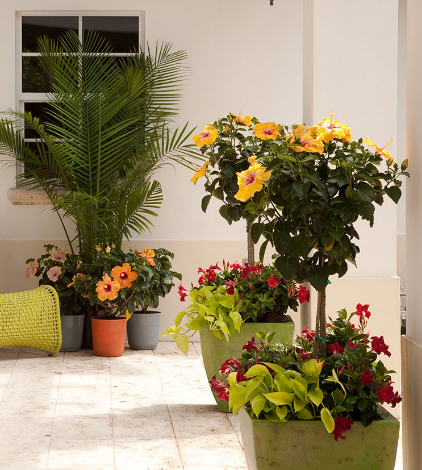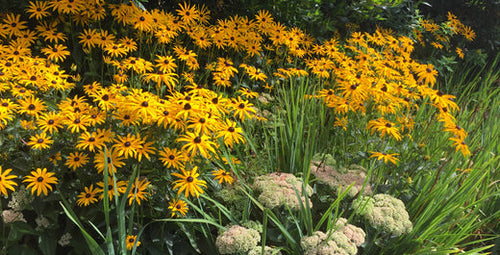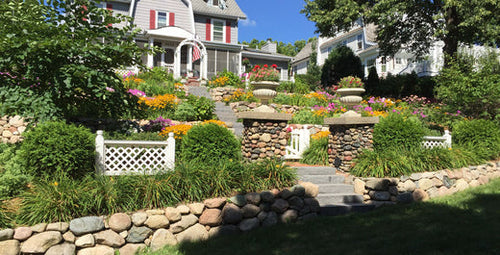
It’s great to collect plants, pots, sundials, benches, and other garden décor and spread them throughout the yard.
But when have you gone too far?
There is a weird fascination with people who overindulge their love of stuff (read hoard). And there’s also weird fascination with the other extreme: minimalist lifestyles where people cast off everything they own and live in houses the size of garden sheds (read the tiny-house craze).
So where is the happy medium in your landscaping?
It sort of depends on your garden style. Do you like a blowsy country gardens or buttoned up formal ones. Is your aesthetic more simple and Zen? Your style interests today will determine the amount of plants and their placement as well as your garden accessories in your garden. But if you think you may have too much going on in your garden, here are some ways to declutter.

Use a Single Focal Point
Designers for centuries have employed a focal point, such as a pedestal in the center of a garden, as a way to draw the eye into the garden. Focal point: it’s a singular noun. Note: There are never 10 pedestals in the center of the garden. There’s just one. If you have a wild rangy garden, adding a single bench or piece of sculpture to bring it into focus as an area.
Group Things Together
But sometimes a focal point can be a group of things, such as a vignette of items. Here, a container, a pair of concrete balls, and a big fern make a pleasing vignette -- and a group-item focal point. If you have a collection, group them together in the yard. For example, are you a gnome collector? Do you love Asian style? Use a small area in your yard to pay homage to your collection. Like a shrine. Designate a bed, border, or side yard and fill it up. Then admire away.
Give Your Plants Some Room
When I first started gardening, I loved to jam small plants together so the garden looked full when it was done. But in a year or two, those perennials got bigger and some took over and covered up those that weren’t as assertive. If you space your plants farther apart, you can mulch in between, and allow some of your plantings some breathing room. If later you decide it looks too spare or your plants haven’t spread out the way you thought they would, you can always add more plants.

Edit Your Landscape
In home décor magazines, they suggest you remove all the things from a room and start bringing things in one by one. While you can’t exactly do the same thing in a garden (well, you could, but it would be painful), you can give good hard looks to the plants you have and determine what should stay. Some plants overgrow their spaces. For example, you can bring overgrown shrubs back into bounds with some careful pruning. Roses and vines can also be cut back to size. Pruning keeps plants from overgrowing their spaces and from looking unkempt. And you can always nip and tuck a landscape by removing dead branches from trees and shrubs and deadheading spent flower blooms.
Bring Together Elements
Another way to make a landscape feel uncluttered is to pull random elements together. If you have several shrubs in your yard, connect them by making an island bed. Drawing a line around elements, stripping out the lawn between them, and adding mulch, makes disparate elements into a community, making things look more orderly.
Tidy Up
If you have a big yard, invest in (or borrow) some essential lawn equipment beyond a mower. Use a blower to remove grass clippings, leaves, and other green debris off your driveway, patio and porch. If mildew grows on sidewalks, walkways, or porch or pergola pillars, use a power washer to remove it. And take a hard look at your walkway edges. Ragged edges look messy and more complicated. Clean edges look orderly and uncluttered. An edger gives you straight lines and crisp edges around walkways and patios, giving the illusion that your yard is neat, trim, and bigger.
Define Your Style -- and Stick to It
Your garden style is your personal expression. So there’s no right or wrong there. But if you love rustic, country style, stay within that style in your landscape décor. For example, you may use galvanized containers, farm-implement-piece sculptures, and bent-twig furniture -- these represent country style. Creating a defined, unified style in your yard allows you to add more pieces without having them feel they don’t belong.
















